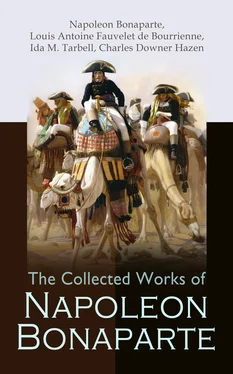Two fine instances of defence in later times are those of Massena at Genoa, and of Palafox at Saragossa.
The first marched out with arms and baggage, and all the honors of war, after rejecting every summons, and defending himself until hunger alone compelled him to capitulate. The second only yielded after having buried his garrison amid the ruins of the city, which he defended from house to house, until famine and death left him no alternative but to surrender. This siege, which was equally honorable to the French as to the Spaniards, is one of the most memorable in the history of war. In the course of it, Palafox displayed every possible resource which courage and obstinacy can supply in the defence of a fortress.
All real strength is founded in the mind; and on this account I am of opinion that we should be directed in the choice of a governor, less by his genius than his personal character. His most essential qualities should be courage, perseverance, and soldierlike devotedness. Above all, he should possess the talent not only of infusing courage into the garrison, but of kindling a spirit of resistance in the whole population. Where the latter is wanting, however art may multiply the defences of a place, the garrison will be compelled to capitulate after having sustained the first, or at most, the second assault.
Table of Contents
The keys of a fortress are well worth the retirement of the garrison, when it is resolved to yield only on those conditions. On this principle it is always wiser to grant an honorable capitulation to a garrison which has made a vigorous resistance, than to risk an assault.
Marshal Villars has justly observed, that “no governor of a place should be permitted to excuse himself for surrendering, on the ground of wishing to preserve the king’s troops. Every garrison that displays courage will escape being prisoners of war. For there is no general who, however well assured of carrying a place by assault, will not prefer granting terms of capitulation rather than risk the loss of a thousand men in forcing determined troops to surrender.”
Table of Contents
Infantry, cavalry, and artillery, are nothing without each other; therefore, they should always be so disposed in cantonments as to assist each other in case of surprise.
“A general,” says Frederick, “should direct his whole attention to the tranquility of his cantonments, in order that the soldier may be relieved from all anxiety, and repose in security from his fatigues. With this view, care should be taken that the troops are able to form rapidly upon ground which has been previously reconnoitered; that the generals remain always with their divisions or brigades, and that the service is carried on throughout with exactness.”
Marshal Saxe is of opinion that an army should not be in a hurry to quit its cantonments, but that it should wait till the enemy has exhausted himself with marching, and be ready to fall upon him with fresh troops when he is overcome with fatigue.
I believe, however, that it would be dangerous to trust implicitly to this high authority, for there are many occasions where all the advantage lies in the initiative, more especially when the enemy has been compelled to extend his cantonments, from scarcity of subsistence, and can be attacked before he has time to concentrate his forces.
Table of Contents
The formation of infantry in line should be always in two ranks, because the length of the musket only admits of an effective fire in this formation. The discharge of the third rank is not only uncertain, but frequently dangerous to the ranks in its front. In drawing up infantry in two ranks, there should be a supernumerary behind every fourth or fifth file. A reserve should likewise be placed twenty-five paces in rear of each flank.
I am of opinion, if circumstances require a line of infantry to resort to a square, that two-deep is too light a formation to resist the shock of cavalry. However useless the third rank may appear for the purpose of file-firing, it is, notwithstanding necessary, in order to replace the men who fall in the ranks in front; otherwise you would be obliged to close in the files, and by this means leave intervals between the companies, which the cavalry would not fail to penetrate. It appears to me, also, that when infantry is formed in two ranks, the columns will be found to open out in marching to a flank. If it should be considered advantageous behind entrenchments to keep the infantry in two ranks, the third rank should be placed in reserve, and brought forward to relieve the front rank when fatigued, or when the fire is observed to slacken. I am induced to make these remarks, because I have seen an excellent pamphlet which proposes the two-deep formation for infantry as the best. The author supports his opinion by a variety of plausible reasons, but not sufficient, as it appears to me, to answer all the objections that may be offered to this practice.
Table of Contents
The practice of mixing small bodies of infantry and cavalry together is a bad one, and attended with many inconveniences. The cavalry loses its power of action. It becomes fettered in all its movements. Its energy is destroyed; even the infantry itself is compromised, for on the first movement of the cavalry it is left without support. The best mode of protecting cavalry is to cover its flank.
This also was the opinion of Marshal Saxe. “The weakness of the above formation,” says he, “is sufficient in itself to intimidate the platoons of infantry, because they must be lost if the cavalry is beaten.”
The cavalry, also, which depends on the infantry for succor, is disconcerted the moment a brisk forward movement carries them out of sight of their supports. Marshal Turenne, and the generals of his time, sometimes employed this order of formation; but that does not, in my opinion, justify a modern author for recommending it in an essay, entitled “Considerations sur l’Art de la Guerre.” In fact, this formation has long been abandoned; and, since the introduction of light artillery, it appears to me almost ridiculous to propose it.
Table of Contents
Charges of cavalry are equally useful at the beginning, the middle, and the end of a battle. They should be made always, if possible, on the flanks of the infantry, especially when the latter is engaged in front.
The Archduke Charles, in speaking of cavalry, recommends that it should be brought in mass upon a decisive point, when the moment for employing it arrives; that is to say, when it can attack with a certainty of success. As the rapidity of its movement enables cavalry to act along the whole line in the same day, the general who commands it should keep it together as much as possible, and avoid dividing it into many detachments. When the nature of the ground admits of cavalry being employed on all points of the line, it is desirable to form it in column behind the infantry, and in a position whence it may be easily directed wherever it is required. If cavalry is intended to cover a position, it should be placed sufficiently in the rear to meet at full speed any advance of troops coming to attack that position. If it is destined to cover the flank of the infantry, it should, for the same reason, be placed directly behind it. As the object of cavalry is purely offensive, it should be a rule to form it at such a distance only from the point of collision as to enable it to acquire its utmost impulse, and arrive at the top of its speed into action. With respect to the cavalry reserve, this should only be employed at the end of a battle, either to render the success more decisive, or to cover the retreat. Napoleon remarks that, at the battle of Waterloo, the cavalry of the guard which composed the reserve, was engaged against his orders. He complains of having been deprived from five o’clock of the use of this reserve, which, when well employed, had so often insured him the victory.
Читать дальше












